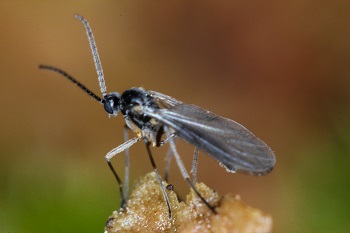Article by Cathy Kavassalis, Halton Master Gardener. Used with the author’s written permission.
ISSUE: Help! I repotted two tropicals with some potting soil that appears to be saturated with little fruit fly-looking beasties! I added a sticky fly tape and it is covered with them. I’ve sprayed both plants with soapy water to no effect! Any ideas on how to stop this would be appreciated. I’m finding them everywhere.
SOLUTION: The good news is that fungus gnats are relatively benign. Adults do not bite and do not harm plants. However, the larvae can do root damage in that volume. Typically, larvae feed on algae, fungi and decaying plant material in soil, but can also feed on root hairs.

So, what to do? First you need to change your cultural practices. You need to let your soil/media dry out. This will kill off the larvae and reduce their food source. Sticky tapes as you are doing can be used to collect the adults so they don’t continue to breed and spread.
Generally, pesticides are not recommended. Mostly because they are not particularly effective at dealing with the larvae. Anything from soaps to pyrethrins (pesticides found naturally in some chrysanthemum flowers) can kill off adults, but these give temporary results as they do not persist long. There are more long lasting synthetic pyrethroids products like Schultz fungus gnat spray (containing Resmethrin) that require less repetition; but honestly, I think you will be able to manage it with cultural changes.
Researchers have found that Bounce® fabric softener dryer sheets (Outdoor Fresh Scent) repel fungus gnat adults and greenhouse producers insert dryer sheets into growing medium. There are ongoing experiments with things like lavender (Lavandula angustifolia Mill.), marjoram (Origanum vulgare L.), and basil (Ocimum basilicum L.) which contain linalool (3,7-dimethyl-1,6-octadien-3-ol) to see it they have the same effect. You might try sprinkling some oregano on the soil surface as an experiment. Sliced potatoes pressed on the surface of the soil are great for drawing the larvae to the surface. They are good for monitoring levels and can be discarded to remove some of the problem.
More Reading:
• Colorado State University Extension. Fungus Gnats as Houseplant and Indoor Pests #5.584
• University of California Agricultural & Natural Resources. Integrated Pest Management Program Fungus Gnats Management Guidelines
• ResearchGate.net Journal of Agricultural and Urban Entomology Jan. 2003, Effect of monitoring technique in determining the presence of fungus gnat Authors: Ana R. Cabrera, Raymond A Cloyd, and Edmond R Zaborski

